<p><br> <span class="small">July 23, 2025</span></p>
How telcos can boost the customer experience with AI
<p><b>Our AI Inclination Index reveals which consumers are most open to using AI in the purchase journey of telecom services—as well as where and how they’ll use it. Knowing this, telcos can develop a highly nuanced and effective consumer-facing AI strategy.</b></p>
<p>The consumer journey for telecom services can be filled with frustration and uncertainty. Artificial intelligence-based tools could go a long way toward making it easier and quicker to select the right mobile plan, set up internet services, properly utilize new tools and devices, and diagnose and resolve technical faults.</p> <p>But consumers’ growing use of AI poses a distinct challenge for telcos as they strive to effectively engage with and retain customers. Which consumers are most (and least) inclined to use AI? Which tool would they prefer to use? And where in the purchase process would they be most comfortable using it? </p> <p>Our recent research uncovered some surprising answers to those questions. Using data from our recent consumer AI study, we developed the AI Inclination Index, which quantifies consumers’ propensity to use AI (see explainer below). While the index reveals a higher-than-average inclination to use AI when purchasing telecom services than other industries’ products and services (see Figure 1), AI attitudes are also far from uniform across the three key phases of the consumer journey (Learn, Buy and Use) and the two telecom product categories in our study:</p> <ul> <li>Internet (i.e., broadband) services</li> <li>Phone (i.e., mobile) services</li> </ul> <p><b>Consider these points of AI usage in the telecoms customer experience:</b></p> <ul> <li><b>The Learn phase is where telecoms consumers are most apt to use AI.</b> The AI inclination score for telecom in the Learn phase is one of the highest of all industries in our study. Scores are virtually the same for mobile and broadband services, with only a one-point difference between the two. Being discoverable by both consumers and AI agents will be critical for all telcos.<br> <br> </li> <li><b>Consumers in the middle age brackets are the most bullish about AI involvement</b>. In most cases, consumers aged 35–54 (and particularly those aged 35–44) are leading the charge in learning, buying and using broadband and mobile services. This age group is economically vital for the sector both because they are at their peak earning age and are more likely than others to own their own home.<br> <br> </li> <li><b>AI tool preference varies according to age and the stage of the purchase journey.</b> While conversational AI is most positively viewed across the board, there are clear signs business will need to be present across multiple channels to woo all consumer cohorts.</li> </ul> <p><b>The AI Inclination Index</b></p> <p><i>To quantify consumers' propensity to adopt AI-driven technology features throughout the consumer journey, we developed the AI Inclination Index. The index was calculated using three measures from our “New minds, new markets” survey data.</i></p>
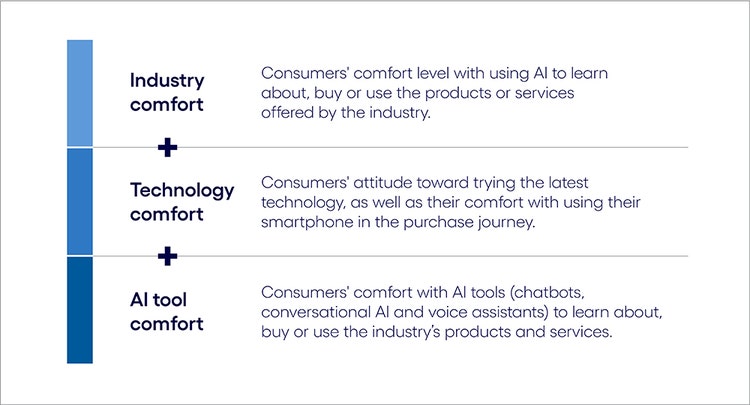
#
<p><b><br> AI inclination in telecoms vs. the global average</b></p> <p><i>Consumers are somewhat more inclined to use AI when purchasing telecommunications products and services than other industries’ goods.</i></p>
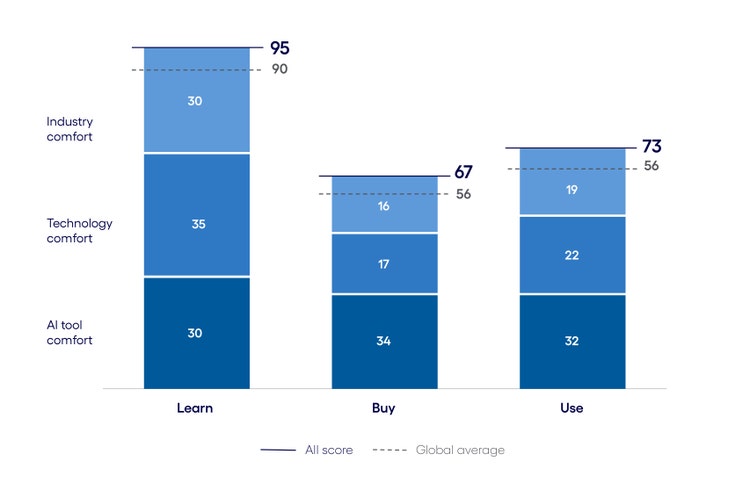
#
<p><span class="small">Figure 1<br> Base: 8,451 respondents in the US, UK, Germany and Australia<br> Source: Cognizant Research</span></p> <p>With these variances, it’s clear telcos will need to craft a precise and nuanced AI strategy that captures the greatest areas of opportunity while avoiding low-value pursuits.</p> <p>Understanding consumer use of AI, as well as the accompanying pockets of spending power, is essential for leaders in all industries. In our global study “<a href="https://www.cognizant.com/us/en/new-minds-new-markets-ai-customer-experience" target="_blank" rel="noopener noreferrer"><b>New minds, new markets</b></a>,” we found that consumers who are enthusiastic about using AI will account for up to 55% of all purchases made across industries. This amounts to $4.4 trillion in spending in the US, $690 billion in the UK, $690 billion in Australia and $540 billion in Germany.</p> <p>In this report, telecom leaders will learn about where in the purchase journey consumers are most and least inclined to use AI, the AI tools they would be most apt to use and how this differs among consumers across age groups. With this information, businesses can reshape their approach to customer engagement—where and how it matters most.</p>
<h4><br> <b>AI across the telecom consumer journey</b></h4> <p>As our telecoms AI Inclination Index indicates, consumers are more bullish about AI than the cross-industry average at every stage of the purchase journey—Learn, Buy and Use. While scores are highest in the Learn stage, the gap with the global average is greatest in the Buy and Use phases, where scores are 18% and 26% higher than the average, respectively.</p> <p>Depending on the region, consumers may have little choice in selecting a provider, or the market may be more competitive. In either case, the telecoms sector is poised for disruption, and consumer adoption of AI is set to catalyze this change.</p> <p>Complex and often confusing service packages make AI particularly attractive at the Learn phase, where consumers strive to identify the most advantageous deals tailored to their specific needs. This desire for simplicity is evidenced by the <a href="https://brandirectory.com/reports/telecoms" target="_blank" rel="noopener noreferrer"><b>significant progress European carriers</b></a> have made in the US market by offering contracts with shorter terms and more flexible switching options. Consumer AI agents could further help to demystify the marketplace.</p> <p>AI’s ability to help consumers switch or renegotiate deals would break the historical trend of pervasive contract inflation and lock-in. The UK’s Citizen Advice Bureau has <a href="https://www.citizensadvice.org.uk/policy/publications/excessive-prices-for-disengaged-consumers-a-super-complaint-to-the-competition-and-markets-authority/#:\~:text=Citizens%20Advice%20has%20submitted%20a,to%20submit%20a%20super%2Dcomplaint.\&text=Read%20our%20loyalty%20penalty%20policy%20research:" target="_blank" rel="noopener noreferrer"><b>estimated</b></a> that eight in 10 consumers were paying higher than average market prices just by sticking with their current provider, kicking off a regulatory investigation.</p> <p>While both mobile and broadband services show nearly equal levels of AI inclination in the Learn and Buy phases, that changes in the Use phase, where consumers are much more interested in embedding AI in their use of broadband services.</p> <p>The value proposition is clear: AI interfaces can help consumers troubleshoot technical issues, test solutions and escalate problems to relevant support teams. While mobile services also show higher than average inclination scores at the Use phase, that product category scores 7 points (or 10%) lower than broadband services.</p>
About our analysis
To understand consumer AI behaviors and attitudes at a granular level, we structured our analysis around four key pillars:
- The consumer journey. We studied the specifics of AI use at each phase of the customer journey. This journey—how consumers discover, purchase and engage with products and services before and after a sale—is at the heart of the business-customer relationship.
- Consumer demographics. To gain a better understanding of how consumer attitudes and behaviors differ by age group, we divided consumers into five categories: 18–24, 25–34, 35–44, 45–54 and 55+.
- Consumer AI tools. We defined consumer AI use by asking about their intended use of three key tools that are prevalent in the consumer world: voice assistants, chatbots and conversational AI.
- Industry-specific products. We included two telecom product categories in our analysis: broadband and mobile services.
<h5><b><br> The Learn phase: A search for the best telecom services deal drives interest in AI</b></h5> <ul> <li><span class="eds-label">Telecom consumers aged 35–44 are the most likely to embrace AI when seeking broadband services</span></li> </ul> <ul> <li><span class="eds-label">Price pressures encourage AI use among low-income telecom consumers</span></li> </ul> <ul> <li><span class="eds-label">Conversational AI is the engagement mode of choice in this phase</span></li> </ul> <p>The Learn phase is where consumers are most inclined to use AI-enabled tools in telecoms for both broadband and mobile services. The index score for the Learn phase is 28 points higher than in the Buy phase and 22 points higher than in Use.</p> <p>AI can help consumers find the best package when seeking a new contract or renewing an existing one. Currently, many consumers don’t bother switching to a new provider or service package, in part because of the time and effort required. This includes consumers—as many as <a href="https://www.ofcom.org.uk/phones-and-broadband/saving-money/in-or-out" target="_blank" rel="noopener noreferrer"><b>20 million customers in the UK alone</b></a>—whose original contract term has lapsed, leaving them with uncompetitive rates. Consumer AI could simplify and streamline these efforts—managing changeovers, using personalized data to right-size service packages, and negotiating with providers to get the best deal.</p> <p>As such, the Learn phase represents a prime opportunity for businesses to capture attention and influence decisions. Doing so starts with understanding what consumers value about using AI in this phase and the AI tools they’re most apt to use.</p> <p><b>Telecoms AI Inclination Index: The Learn phase</b></p>
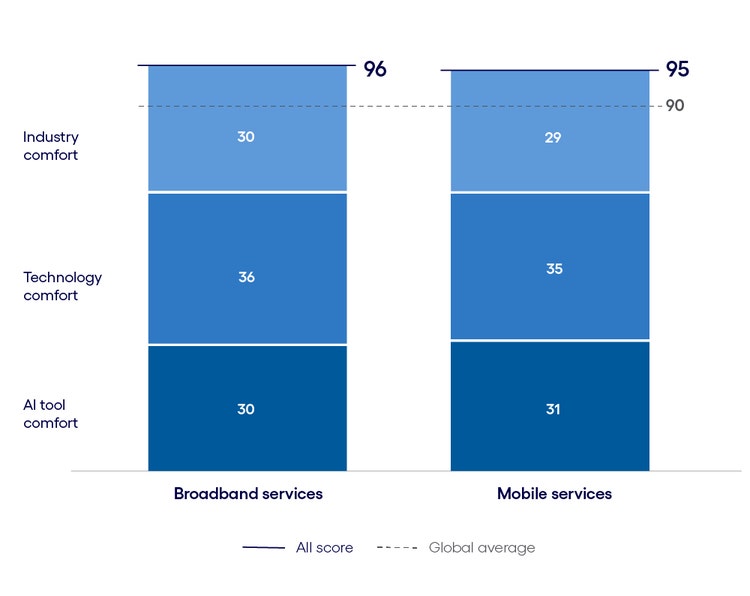
#
<p><span class="small">Figure 2<br> Base: 8,451 respondents in the US, UK, Germany and Australia<br> Source: Cognizant Research</span></p> <p><b>Telecom consumers aged 35–44 are the most likely to embrace AI when seeking broadband services</b></p> <p>When it comes to learning about their options for broadband services, consumers aged 35–44 have an index score of 81, exceeding that of both the oldest cohort (with a score of 74) and the youngest (who scored 55).</p> <p>This age group has a high propensity for using digital technologies, as seen in their technology comfort scores. It’s also an important market for telcos: These consumers represent <a href="https://www.statista.com/statistics/272365/age-distribution-of-internet-users-worldwide/#:\~:text=As%20of%20February%202024%2C%20over,of%20all%20internet%20users%20worldwide." target="_blank" rel="noopener noreferrer"><b>more than 50% of the market</b></a> according to some estimates. They also are the most <a href="https://www.businessinsider.com/work-from-home-boom-millennials-not-gen-z-boomers-2023-11" target="_blank" rel="noopener noreferrer"><b>likely cohort to regularly work from home</b></a>, making internet connectivity vital for both their personal and professional lives.</p> <p>While the youngest consumers (aged 18–24) are often seen as the most connected generation, they’re less likely to make their own internet package selection. <a href="https://blog.ons.gov.uk/2024/04/12/our-changing-population-is-there-for-all-to-see/" target="_blank" rel="noopener noreferrer"><b>In the UK</b></a>, only half of those 24 and under have moved out of their parents’ home, and <a href="https://www.cbsnews.com/newyork/news/why-are-so-many-young-people-living-with-their-parents/" target="_blank" rel="noopener noreferrer"><b>in the US</b></a>, 45% of people aged 18–29 live with their families.</p> <p>Mobile services follow a similar trend but with less pronounced gaps between cohorts. For example, individuals aged 35–44 and 55-plus score a 72 on the inclination index, while the youngest cohort scores 57. Technology attitudes across all age groups are remarkably similar, indicating a well-established presence of digital technologies in the Learn phase of the mobile services journey.</p> <p><b>Price pressures encourage AI use among low-income telecoms consumers</b></p> <p>The lowest-income consumers (those with less than $39,999 in annual income) are more likely to use AI in Learn, scoring 73 on the inclination index compared with 52 for the highest-income group. The most likely reason for this is the need to find the best, most affordable deal.</p> <p>With most telecoms contracts including a credit agreement, lower-income consumers are compelled to seek out suitable terms or merge multiple offerings such as SIM-only plans and pay-as-you-go data use to balance costs.</p> <p>This consumer dynamic is most notable in the broadband services category. Here, there is often a greater difference in price and service quality compared with mobile service contracts, where the device itself represents a large part of the cost and is fairly uniform across providers.</p> <p>These bundled packages represent a large portion of the market—30% in the US and almost <a href="https://www.ofcom.org.uk/phones-and-broadband/bills-and-charges/top-trends-from-our-latest-telecoms-pricing-research#:\~:text=Pay%2Dmonthly%20mobile%20tariffs%20including,taking%20out%20a%20combined%20contract." target="_blank" rel="noopener noreferrer"><b>40% in the UK</b></a>. The alternative of buying the device outright is considered impossible by many people.</p> <p><b>Conversational AI is the engagement mode of choice in this phase</b></p> <p>Of the three AI tools in our study (conversational AI, AI voice assistants and chatbots), conversational AI resonates most highly with consumers. With its ability to simulate human-like interactions and provide relevant information efficiently, conversational AI can help consumers understand complex contracts and find the deal that suits their purposes. As one consumer observed, “I could easily see myself asking a conversational AI system to tell me about better plans to save money or increase speed.”</p> <p>This preference is strongest among younger consumers, who prefer technology solutions that align with their digital fluency and tech-savvy lifestyles. The oldest cohort (55-plus), on the other hand, shows a more even propensity to use all three AI tools—rating conversational AI highly overall but also showing a fondness for digital voice interfaces.</p> <p>The oldest cohort also believes chatbots hold some value when they’re working through new product information in the sector—a notable trend given chatbots generally score poorly at a cross-industry level. Older consumers, it seems, are open to a variety of tools that would simplify complex systems and improve usability.</p>
<h5><span style="font-weight: normal;"><b>The Buy phase: Consumers get skittish with using AI to purchase telecoms services</b></span></h5> <ul> <li><span class="eds-label"><span class="aem-i-header-link">High stakes and complex telecom contracts hamper adoption</span></span></li> </ul> <ul> <li><span class="eds-label"><span class="aem-i-header-link">High-income telecom consumers are more willing to balance AI risk with convenience</span></span></li> </ul> <ul> <li><span class="eds-label"><span class="aem-i-header-link">Younger telecom consumers are the most apt to use AI to purchase broadband services</span></span></li> </ul> <p>Although scores here are still above the global average, the Buy phase is where we see the most hesitation to use AI. Scores in all three areas of the index are much lower than in the Learn phase, particularly the technology comfort component, which drops 69% (or 18 points) and industry comfort, which drops 61% (or 14 points) between the phases.</p> <p>This reluctance to outsource final decision-making to AI is likely due to concerns about the often expensive, multiyear contracts prevalent in the sector—getting it wrong could be costly. However, as with the Learn phase, attitudes differ across consumer age groups and product categories.</p> <p><b>Telecoms AI Inclination Index: The Buy phase</b></p>
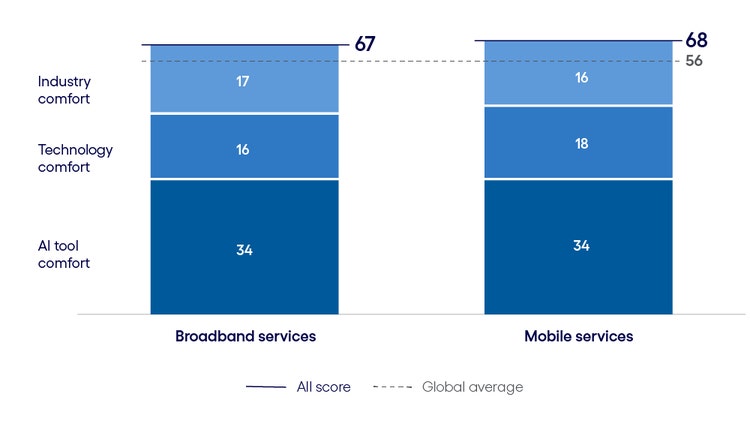
#
<p><span class="small">Figure 3<br> Base: 8,451 respondents in the US, UK, Germany and Australia<br> Source: Cognizant Research</span></p> <p><b>High stakes and complex contracts hamper AI adoption</b></p> <p>In stark contrast with the bullishness seen in the Learn phase, all consumer groups pull back at this phase of the journey. For broadband services, scores for the most positive cohort (those aged 35–44) drop 26 points. For the <a name="_Int_UADLVzQR" id="_Int_UADLVzQR"></a>less engaged youngest group, scores slide 25 points. This trend is more pronounced for mobile services, where scores drop 35 points for 35-to-44-year-olds.</p> <p>Complex and costly broadband and mobile contracts give consumers pause about automating these purchases. The <a href="https://www.highspeedinternet.com/resources/how-much-should-i-be-paying-for-high-speed-internet-resource#:\~:text=Internet%20cost%20and%20annual%20contracts,to%20break%20your%20contract%20early." target="_blank" rel="noopener noreferrer"><b>average broadband contract</b></a> runs 12 to 24 months, costs about $75 a month and stipulates hundreds of dollars in early termination fees. Mobile contracts are similar; the average US consumer spends <a href="https://www.nasdaq.com/articles/the-average-american-spends-$1342-per-year-on-phone-bills-how-to-cut-this-bill-in-half" target="_blank" rel="noopener noreferrer"><b>$1,342 per year on phone bills</b></a>.</p> <p>That said, AI’s role in negotiating a good deal is viewed positively by some. As one consumer pointed out, AI could seamlessly compare “the cost of phone bills and data plans, as well as change my plan for me if it finds a different one that is cheaper or has better offers/prices.”</p> <p>For instance, AI could analyze contract terms, compare pricing plans and suggest tailored services that align with consumers’ needs and lifestyle. Or it could recommend optimal solutions and automate transitions between plans, ensuring seamless service upgrades without manual intervention.</p> <p><b>High-income telecom consumers are more willing to balance AI risk with convenience</b></p> <p>That said, high-income groups (those earning more than $80,000 a year) are slightly more inclined to leverage AI tools for finalizing internet service contracts. This attitude could stem from their ability to more easily absorb the potential financial consequences of early termination fees or high monthly costs and, instead, prioritize convenience.</p> <p>This trend is even more pronounced in the mobile services sector, where the highest-income group significantly outpaces the lowest on the inclination index, sitting 23 points higher.</p> <p><b>Younger telecom consumers are the most apt to use AI to purchase broadband services</b></p> <p>Younger consumers are the most likely group to use AI at the Buy phase, albeit at a much lower level on the inclination index overall. While 18-to-24-year-olds still have the lowest score overall at 30—reflecting the low likelihood of their purchasing internet services—the next youngest consumer group (those aged 25 to 34) have the highest inclination, with a score of 55.</p> <p>This means telcos have an opportunity to embed advanced automation capabilities into the purchase journey for these younger demographics who, over time, will become more economically powerful and more likely to entrust AI agents to handle the Buy phase of the journey.</p>
<h5><span style="font-weight: normal;"><b>The Use phase: Consumers want AI to help manage telecom service performance and handle renewals</b></span></h5> <ul> <li><span class="eds-label">Even skeptical cohorts see value in AI for managing their use of broadband services</span></li> </ul> <ul> <li><span class="eds-label">Conversational AI is the path to effective customer support, especially for older consumers</span></li> </ul> <p>Consumers’ inclination to use AI increases significantly in the Use phase. Inclination index scores in this phase surpass the economy-wide average, with broadband services taking a commanding lead (see Figure 4).<b> </b>From the Buy phase to the Use phase, the broadband services category picks up 10 points, while the mobile services category increases by 2.</p> <p>Driving this change is a clear demand from consumers to help manage often troublesome internet contracts, manage performance issues and proactively work to ensure service quality remains high.</p> <p><b>Telecoms AI Inclination Index: The Use phase</b></p>
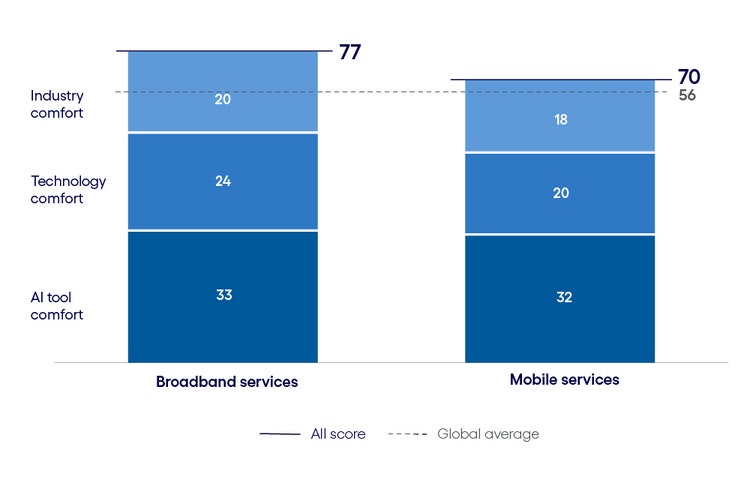
#
<p><span class="small">Figure 4<br> Base: 8,451 respondents in the US, UK, Germany and Australia<br> Source: Cognizant Research</span></p> <p><b>Even skeptical cohorts see value in AI for managing their use of broadband services</b></p> <p>Consumers across the board would like AI to enhance their use of broadband services, with above-average scores across most age groups. The consistently positive 35–44 cohort holds the highest position on the inclination index for broadband services, scoring 65, followed by the oldest cohort (55+) at 59. Indeed, <a href="https://www.pewresearch.org/internet/2024/01/31/americans-use-of-mobile-technology-and-home-broadband/#:\~:text=%27Smartphone%2Ddependent%27%20adults\&text=Those%20who%20live%20in%20lower,%2430%2C000%20to%20%2469%2C999%20per%20year" target="_blank" rel="noopener noreferrer"><b>nine-in-10 US adults</b></a> now say they go online every day. This includes 41% who report using the internet almost constantly. Service quality matters.</p> <p>As one consumer argued, AI could “help me by optimizing service management and improving network management. AI-driven chatbots could help with troubleshooting and identify potential service disruptions before they impact me.”</p> <p>Even skeptical generations see the value of injecting AI into their use of internet services. The youngest cohort, for example, sees a 64% increase in inclination between Buy and Use, largely because of their keenness for quality connectivity services—note that this group participates most in <a href="https://www.uswitch.com/broadband/studies/online-gaming-statistics/#:\~:text=Which%20age%20group%20plays%20the,UK%20gamers%20are%20aged%2065\+." target="_blank" rel="noopener noreferrer"><b>bandwidth-hungry online gaming</b></a>.</p> <p>Consumers also see AI’s potential for real-time allocation of internet bandwidth in the home. “If device X is watching Netflix and device Y is idle, push the bandwidth to device X and throttle it back for device Y,” one said.</p> <p><b>Conversational AI is the path to effective customer support, especially for older consumers</b></p> <p>With this in mind, it’s no surprise to see conversational AI return as the most positively viewed AI tool. In the Use phase, however, the tool gains in popularity as generations get older.</p> <p>According to <a href="https://www.ageuk.org.uk/latest-press/articles/2024/more-than-1-in-3-over-65s-4.7-million-lack-the-basic-skills-to-use-the-internet-successfully/#:\~:text=10:51%20AM-,More%20than%201%20in%203%20over%2065s%20(4.7%20million)%20lack,day%2Dto%2Dday%20life." target="_blank" rel="noopener noreferrer"><b>Age UK</b></a>, older consumers often struggle to diagnose issues with their telecom products and are less able to resolve issues even when they get support. Conversational AI solutions could walk consumers through fixes or present more digestible walkthroughs and diagnostic tests.</p> <p>Beyond troubleshooting, conversational AI could serve as a proactive assistant, offering personalized recommendations and timely alerts. For instance, it could identify patterns of high data usage and notify customers before they exceed their limits, or suggest tailored upgrades based on their usage history.</p> <p>By integrating predictive analytics, these systems could empower consumers to make informed decisions about their telecom services while simultaneously reducing the need for manual intervention. This blend of functionality and foresight positions conversational AI as an indispensable tool for both enhancing customer satisfaction and streamlining the user experience in the telecom sector.</p>
<h4><b>Meeting consumers where they are in the telecom customer journey</b></h4> <p>Consumer use of AI is growing fast and, with it, the emergence of consumer AI agents. These agents will act like a personal digital concierge, orchestrating complex tasks across the purchase journey. Soon, the internet as we know it will become the agentic internet: an interconnected ecosystem of AI-enabled tools and agents that autonomously locate, evaluate, purchase and maintain the products and services they rely on.</p> <p>Based on our research, it’s likely consumer AI uptake will be somewhat faster in the telecom sector than in other industries. We believe leaders have less than five years to navigate this change.</p> <p>To prepare for the AI-driven consumer era ahead, telcos will need to rethink how they operate across these four areas:</p> <ul> <li><b>Focus on both AI platform and device applications. </b>AI platforms are anticipated to be a critical component of the modern internet and are already a vital aspect of modern search. As such, telcos need to balance being easily found on major AI platforms while also fulfilling customer expectations by incorporating AI into services and devices.<br> <br> For the former, telcos will need to create a consistent set of APIs for platforms to access data and present it to current and prospective clients. In terms of the latter, the smartphone industry is progressively embedding AI capabilities into handsets. Today, <a href="https://omdia.tech.informa.com/insights/2025/now-and-next-for-ai-capable-smartphones-1" target="_blank" rel="noopener noreferrer"><b>approximately 16%</b></a> of smartphones are AI-capable, and this is projected to rise to 54% by 2028.<br> <br> This trend highlights the increasing role of handsets as not only communication tools but also as intelligent systems that manage user needs. As these devices become more advanced, telecom service providers must take advantage of this shift, ensuring their services are efficiently integrated and optimized for AI-based functionality.<br> <br> </li> <li><b>Leverage conversational AI for proactive and reactive support.</b> Telcos should prioritize conversational AI as a cornerstone of their customer support strategies. These tools can help to not only troubleshoot issues in real time but also proactively assist users. By integrating predictive analytics, conversational AI systems could monitor usage patterns, send timely alerts (i.e., for high data usage) and recommend personalized upgrades.<br> <br> In particular, emphasizing the accessibility of these tools for older consumers—who often struggle with diagnosing and resolving issues—could significantly enhance user satisfaction. Providing easy-to-follow walkthroughs, conducting diagnostic tests and offering step-by-step guidance can make troubleshooting less daunting, positioning companies as innovative and consumer-focused.<br> <br> Moreover, conversational AI solutions could reduce operational costs significantly. By automating routine customer service interactions and resolving minor issues without human intervention, businesses can lower the demand for extensive call center staffing.<br> <br> Additionally, AI-powered monitoring systems can optimize network operations by detecting and addressing inefficiencies before they escalate, ensuring seamless service delivery while minimizing costly outages.<br> <br> In the future, we anticipate these shifts will push the industry away from its embedded per-seat model, to one that focuses on outcomes—deploying a hybrid human-AI workforce to focus on specific objectives such as revenue generation and customer satisfaction.<br> <br> </li> <li><b>Design AI-led operations that boost customer experience and aid the bottom line. </b>AI-led operations have a dual benefit of improving consumer experience while also driving down operating expenditures.<br> <br> Consumers have a clear appetite to see AI enhance service quality, such as dynamically adjusting internet bandwidth based on household device usage. This approach not only enhances the customer experience by providing seamless streaming and browsing but also allows telcos to reduce their operational expenditures.<br> <br> By optimizing network resource allocation and minimizing inefficiencies, AI-driven bandwidth management can decrease energy consumption and lower costs associated with manual interventions, making operations more sustainable and economically efficient.<br> <br> </li> <li><b>Focus on AI-enhanced service quality monitoring. </b>Consumers have expressed a strong desire for AI to help ensure service quality and address issues rapidly. Telcos should develop AI systems that can monitor and manage service quality in real time.<br> <br> These tools could proactively identify potential issues, alert customers to disruptions and even resolve minor problems without requiring human intervention. By offering this level of proactive support, telecom can significantly improve customer satisfaction and reduce the need for traditional customer service calls, ultimately streamlining operations and building trust with their customers.</li> </ul>
Jump to a section
Introduction #spy-1
AI across the telecommunications consumer journey #spy-2
subnav- The Learn phase: A search for the best telecom services deal drives interest in AI#spy-3
subnav- The Buy phase: Consumers get skittish with using AI to purchase telecoms services#spy-4
subnav- The Use phase: Consumers want AI to help manage telecom service performance and handle renewals#spy-5
Meeting consumers where they are in the telecom customer journey #spy-6
<h5>Authors</h5>




